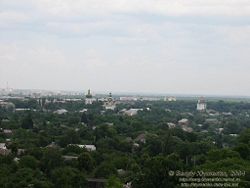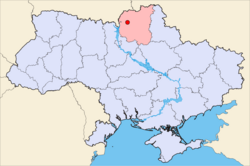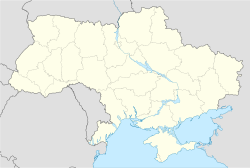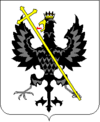Chernihiv
| Chernihiv Чернігів |
|||
 |
|||
|
|||
 |
|||
 Chernihiv
|
|||
| Coordinates: | |||
| Country Oblast Raion |
Ukraine Chernihiv Oblast Chernihivskyi Raion |
||
|---|---|---|---|
| Founded | 907 | ||
| Government | |||
| - Mayor | Oleksandr Sokolov | ||
| Area | |||
| - Total | 79 km² (30.5 sq mi) | ||
| Population (2005) | |||
| - Total | 300,500 | ||
| - Density | 1,547/km² (4,006.7/sq mi) | ||
| Postal code | 14000- | ||
| Area code(s) | + 380 462 | ||
| Website: www.chernigiv-rada.gov.ua | |||
Chernihiv, (Ukrainian: Чернігів, also known as Chernigov Russian: Чернигов; Belarusian: Чарнігаў), is a historic city in northern Ukraine. It is the administrative center of the Chernihiv Oblast (province), as well as of the surrounding Chernihivskyi Raion (district) within the oblast. The estimated population of the city is around 299,000 (as of 2006).
Contents |
History
Chernihiv was first mentioned in the Rus'-Byzantine Treaty (907) (as Черниговъ), but is considered to have existed at least in the ninth century, as uncovered by archaeological excavations of a settlement which included the artifacts from the Khazar Khaganate. Towards the end of the 10th century, the city probably had its own rulers. It was there that the Black Grave, one of the largest and earliest royal mounds in Eastern Europe, was excavated back in the 19th century.
In the southern portion of the Kievan Rus the city was the second by importance and wealth.[1] From the early eleventh century it was the seat of powerful Grand Principality of Chernigov, whose rulers at times vied for power with Kievan Grand Princes, and often overthrew them and took the primary seat in Kiev for themselves. The grand principality was the largest in Kievan Rus and included not only the Severian towns but even such remote regions as Murom, Ryazan and Tmutarakan. The golden age of Chernigov, when the city population peaked at 25,000, lasted until 1239 when the city was sacked by the hordes of Batu Khan, which started a long period of relative obscurity.

The area fell under the Grand Duchy of Lithuania in 1353. The city was burned again by Crimean khan Meñli I Giray in 1482 and 1497 and in the fifteenth to seventeenth centuries it changed hands several times between Lithuania, Muscovy (1408–1420 and from 1503), and the Polish-Lithuanian Commonwealth (1618–1648), where it was granted Magdeburg rights in 1623 and in 1635 became a seat of Chernigov Voivodship. The area's importance increased again in the middle of the seventeenth century during and after the Khmelnytsky Uprising. In the Hetman State Chernihiv was the city of deployment of Chernihiv Cossack regiment (both a military and territorial unit of the time).
Under the 1667 Treaty of Andrusovo the legal suzerainty of the area was ceded to Tsardom of Russia, with Chernihiv remaining an important center of the autonomous Cossack Hetmanate. With the abolishment of the Hetmanate, the city became an ordinary administrative center of the Russian Empire and a capital of local administrative units. The area in general was ruled by the Governor-General appointed from Saint Petersburg, the imperial capital, and Chernigov was the capital of local namestnichestvo (province) (from 1782), Malorosiyskaya or Little Russian (from 1797) and Chernigov Governorate (from 1808).
According to the census of 1897 there were in the town of Chernihiv about 11,000 Jews in a total population of 27,006. The chief occupations of the Jews are industrial and commercial. In the neighborhood many tobacco-plantations and fruit-gardens are owned by Jews. There are in Chernihiv 1,321 Jewish artisans, including 404 tailors and seamstresses, but the demand for artisan labor is limited to the town. There are 69 Jewish (day-laborers, almost exclusively teamsters. But few are engaged in the factories. [2]
Downtown


Chernihiv's architectural monuments chronicle two most flourishing periods in the city's history - those of Kievan Rus (11th and 12th centuries) and of the Cossack Hetmanate (late 17th and early 18th centuries.)
The oldest church in the city and in the whole of Ukraine is the 5-domed Saviour Cathedral, commissioned in the early 1030s by Mstislav the Bold and completed several decades later by his brother, Yaroslav the Wise. The Cathedral of Sts Boris and Gleb, dating from the mid-12th century, was much rebuilt in succeeding periods, before being restored to its original shape in the 20th century. Likewise built in brick, it has a single dome and six pillars. The crowning achievement of Chernigov masters was the exquisite Church of St Paraskeba (Pyatnitskaya), constructed at the turn of the 12th and 13th centuries. This graceful building was seriously damaged in the Second World War; its original medieval outlook was reconstructed to a design by Peter Baranovsky.
The earliest residential buildings in the downtown date from the late 17th century, a period when a Cossack regiment was deployed there. Two most representative residences are those of Polkovnyk Lyzohub (1690s) and Polkovnyk Polubutok (1700s). The former mansion, popularly known as the Mazepa House, used to contain the regiment's chancellery. One of the most profusely decorated Cossack structures is undoubtedly the ecclesiastical collegium, surmounted by a bell-tower (1702). The archbishop's residence was constructed nearby in the 1780s. St Catherine Church (1715), with its 5 gilded pear domes, traditional for Ukrainian architecture, is thought to have been intended as a memorial to the regiment's exploits during the storm of Azov in 1696.
Monasteries
All through the most trying periods of its history, Chernihiv retained its ecclesiastical importance as the seat of bishopric or archbishopric. At the outskirts of the modern city lie two ancient cave monasteries, formerly used as the bishops' residences.
The caves of the Eletsky Monastery are said to predate those of the Kiev Pechersk Lavra (Kiev Monastery of the Caves). Its magnificent 6-pillared cathedral was erected at the turn of the 11th and 12th centuries; some traces of its 750-year-old murals may still be seen in the interior. After the domes collapsed in 1611, they were augmented and reconstructed in the Ukrainian baroque style. The wall, monastic cells, and bell-tower all date from the 17th century. The nearby mother superior's house is thought to be the oldest residential building in the Left-Bank Ukraine. The cloister's holiest icon used to be that of Theotokos, who made her epiphany to Svyatoslav of Chernigov on February 6, 1060. The icon, called Eletskaya after the fir wood it was painted upon, was taken to Moscow by Svyatoslav's descendants - Princes Boryatinsky - in 1579.
The nearby cave monastery of St Elijah and the Holy Trinity features a small eponymous church, which was constructed 800 years ago. The roomy Trinity cathedral, one of the most imposing monuments of the Cossack baroque, was erected between 1679 and 1689. Its refectory, with the adjoining church of Presentation to the Temple, was finished by 1679. There are also the 17th-century towered walls, monastic cells, and the 5-tiered belfry from the 1780s.
Other historic abbeys may be visited in the vicinity of Chernihiv; those in Kozelets and Hustynya contain superb samples of Ukrainian national architecture. The area is served by Chernihiv Shestovitsa Airport, and during the Cold War it was the site of Chernigov air base.
Famous people from Chernihiv
- Ossip Maximovitch Bodyanskiy, a Russian-Ukrainian Slavist, writer, and historian
- Anatoly Rybakov, a Russian writer
- Vladimir Antonov-Ovseenko, a prominent Soviet Bolshevik leader and diplomat.
Sister cities of Chernihiv
Chernihiv is currently twinned with:
![]() Bryansk
Bryansk
![]() Perm
Perm
![]() Mytischi
Mytischi
![]() Homyel
Homyel
![]() Memmingen
Memmingen
![]() Tarnobrzeg
Tarnobrzeg
References
- Inline:
- ↑ Nasledie Svyatoy Rusi URL accessed on January 12, 2006
- ↑ jewishencyclopedia.com Copy from 12-volume Jewish Encyclopedia, which was originally published between 1901-1906.
- Logvin, G.N. (Г. Н. Логвин) (1965). Chernigov, Novgorod-Seversky, Glukhov, Putivl (Чернигов, Новгород-Северский, Глухов, Путивль). Moscow. (Russian)
- Pyotr Rappoport (П. А. Раппопорт) (1993). Ancient Russian Architecture (Древнерусская архитектура). Saint-Petersburg. (Russian)
- Martin Dimnik (2003). The Dynasty of Chernigov, 1146-1246. Campridge University Press. ISBN 0-521-82442-7.
- (1972) Icтopia мicт i ciл Укpaїнcькoї CCP - Чернiгiвськa область (History of Towns and Villages of the Ukrainian SSR - Chernihiv Oblast), Kyiv. (Ukrainian)
External links
http://www.ofmycity.com/ webportal of the Chernihiv City
http://www.chernigov-ukraine.info/ Chernigov Ukraine Information. Guide to apartments, marriage agency, sites, bars, restaurants, and other information on Kiev Ukraine
- chernigiv-rada.gov.ua — Official webportal of the Chernihiv City Rada (Ukrainian)/(English)
- Chernihiv in the Encyclopedia of Ukraine
- princelycity.cn.ua — Chernihiv: the Princely City of Ukraine
- gls.cn.ua — Sketch of Chernigov's history
- klymenko.data-tec.net - Photographs of Chrenihiv with some history
- ch-turizm.com.ua/ — Touristic Chernigov
- chernihiv-oblast.gov.ua — Invest in Chernihiv Oblast
- "Chernigov-Gethsemane" Icon of the Mother of God. Russian Orthodox Cathedral of St. John the Baptist, Washington DC. (ROCOR).
|
||||||||||||||||||||
|
|||||||||||||||||

